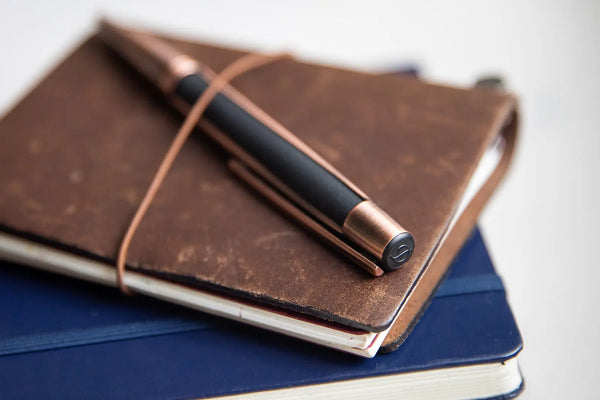Pens are an essential part of our daily lives, used for everything from jotting down notes to creating art. But did you know that there are various types of pens, each with its own unique features and purposes? In this comprehensive guide, we'll explore the world of pens, from traditional to modern, so you can choose the perfect pen for your needs.
1. Ballpoint Pens
Ballpoint pens are perhaps the most common type of pen and a staple in offices and schools worldwide. These pens use a tiny rotating ball bearing at the tip, which dispenses a thick, oil-based ink. They are known for their reliability, durability, and the ability to write smoothly on various surfaces.
Pros:
-
Long-lasting ink.
-
Virtually smudge-proof.
-
Works on most surfaces.
Cons:
-
Limited ink color options.
-
May require more pressure to write.
Click Here to Shop all Ballpoint Pens

2. Fountain Pens
Fountain pens are a symbol of elegance and sophistication. They use a nib and ink reservoir to create a flowing, smooth writing experience. Fountain pens come in a wide range of designs and materials, making them a collector's item for some.
Pros:
-
Exceptionally smooth writing.
-
Wide variety of ink colors.
-
Customizable nibs for different writing styles.
Cons:
-
Learning curve for maintenance and proper use.
-
More prone to ink smudging.
Click Here to Shop all Fountain Pens

3. Rollerball Pens
Rollerball pens combine the best of ballpoint and fountain pens. They use water-based ink, offering the smoothness of a fountain pen with the convenience of a ballpoint pen. Rollerball pens are known for their vibrant ink colors and comfortable writing experience.
Pros:
-
Smooth and consistent ink flow.
-
Diverse ink color options.
-
Excellent for detailed writing and drawing.
Cons:
-
Ink can smudge if not given time to dry.
-
May require more frequent refills.
Click Here to Shop all Rollerball Pens

4. Gel Pens
Gel pens are a favorite among students and artists for their bold, opaque lines and vibrant ink. They use a gel-based ink that is thicker and more opaque than the ink in rollerball pens. Gel pens come in a wide range of colors and are excellent for adding a pop of color to your notes or artwork.
Pros:
-
Smooth writing experience.
-
Wide variety of colors.
-
Ideal for detailed work and coloring.
Cons:
-
May skip if not used regularly.
-
Ink may take longer to dry.
5. Felt-Tip Pens
Felt-tip pens, also known as marker pens, are popular for their versatility. They have a felt or fiber tip that allows for both fine and broad strokes. Felt-tip pens are available in a variety of ink types, including water-based and permanent, making them suitable for various applications.
Pros:
-
Precise and consistent lines.
-
Ideal for drawing and coloring.
-
Long-lasting and smudge-resistant.
Cons:
-
Ink may dry out if left uncapped.
-
Limited ink color options.
6. Brush Pens
Brush pens are a favorite among artists and calligraphers. They feature a flexible brush-like tip that can create a wide range of strokes, from fine lines to bold, sweeping curves. These pens come in various ink types, including watercolor, making them ideal for blending and layering colors.
Pros:
-
Versatile for creating various artistic effects.
-
Great for calligraphy and lettering.
-
Wide range of ink colors and types.
Cons:
-
May require practice for precise control.
-
Limited for general writing tasks.
7. Multi-Function Pens
Multi-function pens, often called "multi-pens," are designed to accommodate multiple ink colors or functions within a single pen body. They are perfect for those who require different ink colors for various tasks, such as note-taking, editing, and highlighting.
Pros:
-
Compact and convenient.
-
Saves space in your pen case.
-
Ideal for multitasking.
Cons:
-
Limited ink capacity for each function.
-
May feel bulkier than single-function pens

